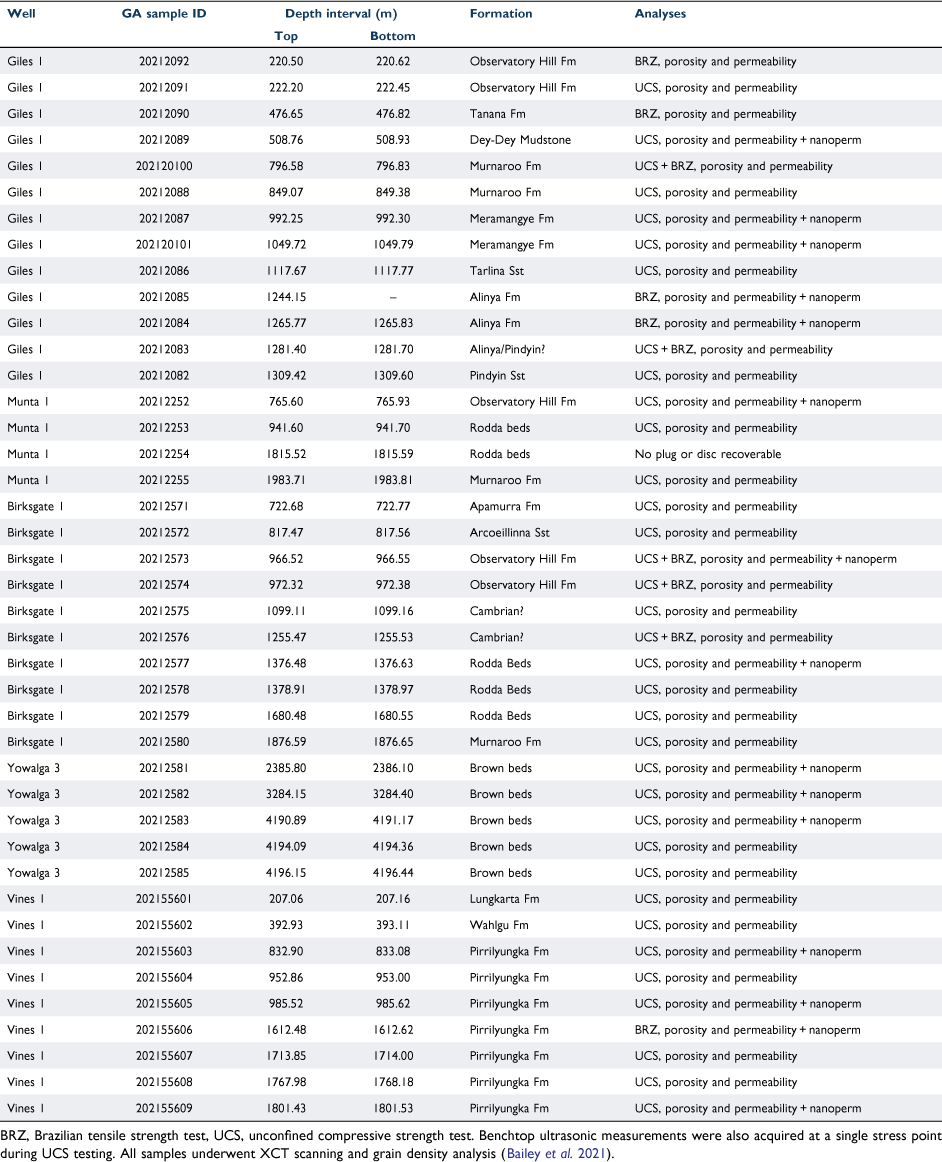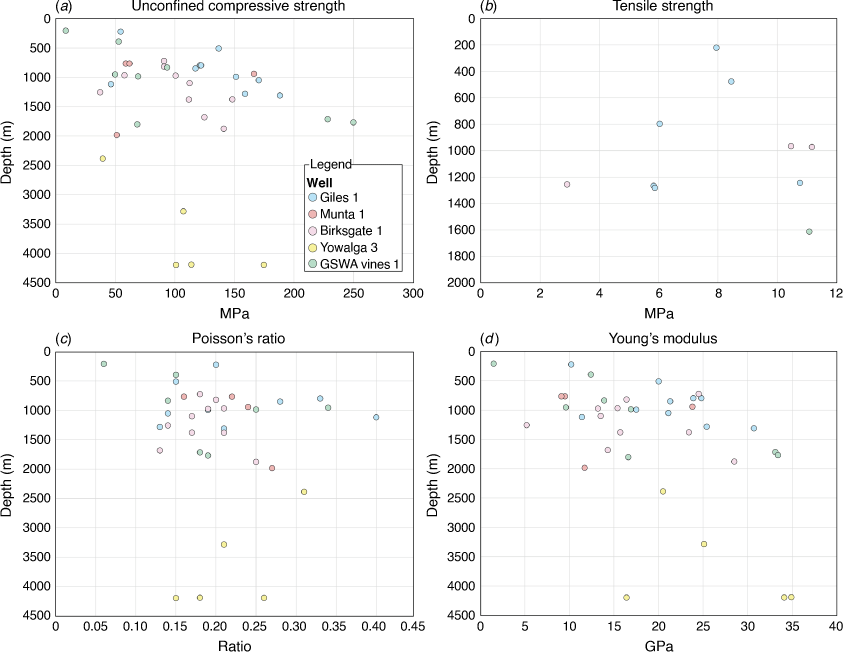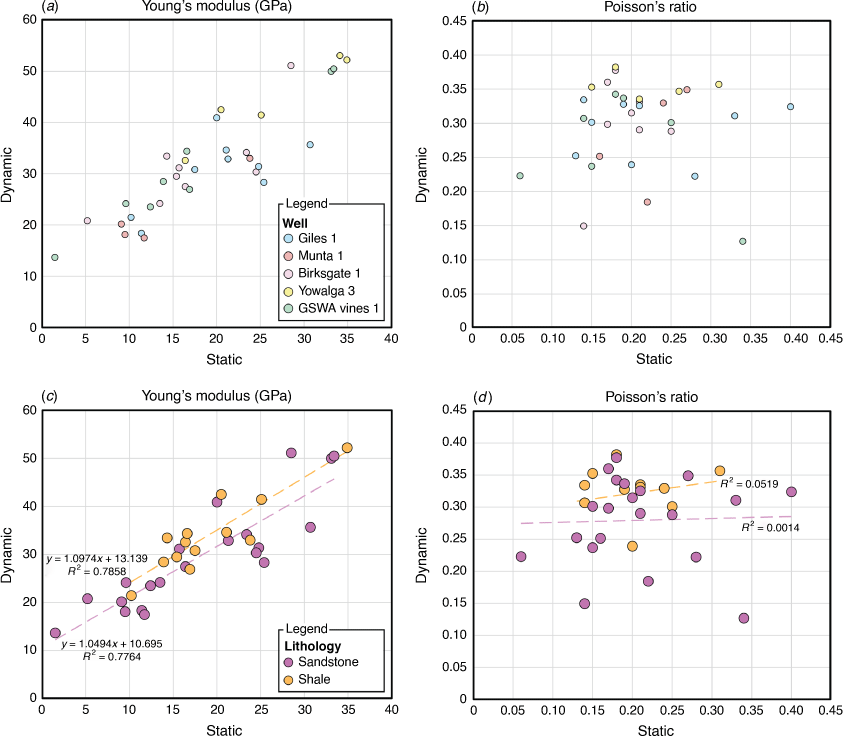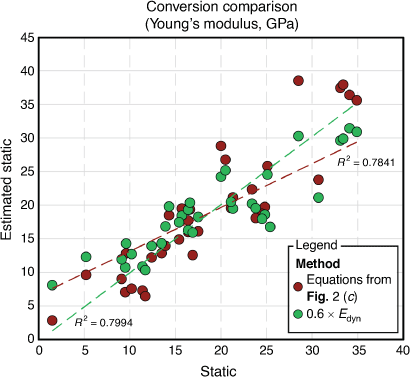Geomechanical rock properties of the Officer Basin
Adam H. E. Bailey A * , Liuqi Wang A , Dave N. Dewhurst B , Jade R. Anderson A , Lidena K. Carr A and Paul A. Henson AA Geoscience Australia, Canberra, ACT, Australia.
B CSIRO, Perth, WA, Australia.
The APPEA Journal 62 S385-S391 https://doi.org/10.1071/AJ21083
Accepted: 8 March 2022 Published: 13 May 2022
© 2022 The Author(s) (or their employer(s)). Published by CSIRO Publishing on behalf of APPEA. This is an open access article distributed under the Creative Commons Attribution 4.0 International License (CC BY).
Abstract
The Officer Basin spanning South Australia and Western Australia is the focus of a regional stratigraphic study being undertaken as part of the Exploring for the Future (EFTF) program, an Australian Government initiative dedicated to increasing investment in resource exploration in Australia. Despite numerous demonstrated oil and gas shows, the Officer Basin remains a frontier basin for energy exploration with significant uncertainties due to data availability. Under the EFTF Officer–Musgrave Project, Geoscience Australia acquired new geomechanical rock property data from forty core samples in five legacy stratigraphic and petroleum exploration wells that intersected Paleozoic and Neoproterozoic aged intervals. These samples were subjected to unconfined compressive rock strength tests, Brazilian tensile strength tests and laboratory ultrasonic measurements. Petrophysical properties were also characterised via X-ray computerised tomography scanning, grain density and porosity-permeability analysis. Accurate characterisation of static geomechanical rock properties through laboratory testing is essential. In the modern exploration environment, these datasets are a precompetitive resource that can simplify investment decisions in prospective frontier regions such as the Officer Basin.
Keywords: Exploring for the Future, geomechanics, laboratory testing, Neoproterozoic Basins, Officer Basin, Officer-Musgrave Project, Paleozoic Basins, petrophysics, Poisson’s ratio, rock properties, static to dynamic, unconfined compressive strength, unconventional hydrocarbons, Young’s modulus.
Introduction
The Australian Government’s Exploring for the Future program (EFTF) launched in 2016 with A$100.5 million of funding provided to Geoscience Australia to explore Australia’s resource potential and boost investment in northern Australia. In 2020, an additional A$125 million of funding was announced to expand the program nationwide until 2024. The EFTF energy component aims to attract industry investment by delivering a suite of new precompetitive geoscience data and knowledge of the hydrocarbon prospectivity of Australian sedimentary basins. The Officer Basin of South Australia and Western Australia is one of the key study areas under investigation as part of this expanded EFTF program, and is currently the focus of a regional stratigraphic study.
The Officer Basin remains a frontier basin for hydrocarbon exploration with significant uncertainties around prospectivity and stratigraphy that arise from the lack of precompetitive geoscience data. While numerous hydrocarbon shows have been observed in wells throughout the basin, no accumulations have yet been found. Geoscience Australia’s Onshore Basin Inventory (Hashimoto et al. 2016) identified several key knowledge gaps in the Officer Basin that if addressed could impact prospectivity. One area was the need for a better understanding of basin sediment rock properties through new data analysis, particularly looking at the reservoir and seal potential of postulated unconventional and conventional targets. Geomechanical studies to understand the recoverability of hydrocarbons from low-permeability reservoir rocks in the basin were also recommended.
To address these knowledge gaps, Geoscience Australia undertook a series of petrophysical and geomechanical analyses on legacy core samples from five Officer Basin stratigraphic and petroleum exploration boreholes that intersected Cambrian and Neoproterozoic successions. This work contributes to a larger-scale regional stratigraphic study, which also includes new chemostratigraphy, geochemistry, fluid inclusion stratigraphy, thin section petrography, conventional wireline log interpretation and neural network identification of petrophysical parameters (Carr et al. 2022). Further detail on the petrophysical work is included in this volume (Wang et al. 2022).
Geological setting
The Neoproterozoic to Paleozoic Officer Basin is an intracratonic sedimentary basin that covers approximately 525 000 km2 over South Australia and Western Australia. It is a remnant of the Neoproterozoic Centralian Superbasin that is bound by the Yilgarn Craton to the west, Musgrave Block to the north and Gawler Craton to the southeast (Hashimoto et al. 2016). The Officer Basin contains up to 10 km of marine and non-marine siliciclastic and carbonate rocks, with minor volcanics. Sediments were primarily deposited within a series of sub-basins that run parallel to the northern basin margin. While no hydrocarbon accumulations have been identified, numerous hydrocarbon shows have been recorded in a range of formations from the Neoproterozoic to the overlying Permian sequences. The basin is likely prospective for both conventional and unconventional hydrocarbons, with salt tectonics providing numerous trapping mechanisms and extensive carbonate intervals that may host stratigraphic traps (Apak and Moors 2001; Carlsen et al. 2003). To date, a total of 75 petroleum and stratigraphic wells have been drilled in the Officer Basin. Hence, while core, cuttings and basic wireline data suites are available, data density is very low and significant uncertainties arise from the lack of data. As part of EFTF, Geoscience Australia is working to maximise knowledge of the basin by analysing new data from existing well samples.
Rock property testing
Forty one samples from Officer Basin wells, from both Western Australia and South Australia, were analysed in this study (Table 1). Samples were selected from intervals considered to have potential as either conventional or unconventional reservoirs while being representative of lithologies intersected by drillcore throughout the basin. Sampling was largely dependent on core integrity with subsequent testing undertaken by the CSIRO Geomechanics and Geophysics Laboratory in Perth. Tests included:
Photographic and 2D X-ray computerised tomography (XCT) scan images of whole core and core plugs;
Unconfined compressive strength (UCS) parameters;
Stress–strain–time curves for UCS experiments;
Tensile strength characteristics;
Static elastic properties, Young’s modulus (E) and Poisson’s ratio (v);
Dynamic elastic properties, velocity, Vp/Vs ratio, Youngs, Bulk and Shear moduli plus Poisson’s ratio;
Gas porosity and permeability; and
Grain density.

|
Background, methods and results were provided to Geoscience Australia by CSIRO Energy and are summarised in Bailey et al. (2021). Cylindrical core plugs approximately 25 mm in diameter and 50 mm in length were prepared normal to bedding for UCS testing, and where core was unable to yield a plug suitable for UCS testing, an approximately 25 mm by 10–15 mm disc was extracted for Brazilian tensile strength (BRZ) testing.
The results of the geomechanical and petrophysical analyses are detailed in Bailey et al. (2021), with the geomechanical results discussed herein (Table 1). Discussion of the petrophysical results can be found in Wang et al. (2022), where the authors discuss the results alongside well log interpretation using both conventional and neural network methods.
Geomechanical properties
A total of 47 UCS and BRZ tests were undertaken, including two repeat tests. Static values for UCS, tensile strength, E and v were acquired and are summarised in Fig. 1, with details available in Bailey et al. (2021). Benchtop ultrasonic measurements were also acquired at a single stress point during UCS testing with dynamic rock properties calculated from these data (Fig. 2).

|

|
Crossplots of laboratory measured (static) and ultrasonic derived (dynamic) Young’s modulus and Poisson’s ratio illustrate the relationships between these parameters in the Officer Basin, both by well and by generalised lithology (Fig. 2). Typically, static and dynamic properties differ due to the difference in inelastic effects (e.g. Ciccotti and Mulargia 2004); Davarpanah et al. (2020) attribute the discrepancies between dynamic and static elastic moduli to microcracks and pores. Brotons et al. (2016) note that the ratio between elastic moduli tends to decrease in very stiff and compact rocks, and increases as stiffness and compactness decrease. Generally, static moduli are likely to be slightly lower than dynamic moduli, however, variations of up to an order of magnitude are not uncommon (Ciccotti and Mulargia 2004).
Static and dynamic Young’s modulus (Estat and Edyn, respectively) measurements from the Officer Basin demonstrate a clear relationship when plotted against one another, with correlation coefficients (R2 values, Fig. 2c) of 0.7858 and 0.7764 for shales and sandstones, respectively (Fig. 2). While there is some scattering of values, there is a clear trend evident in the data. Dynamic values are consistently observed to be higher than static values; the difference between Estat and Edyn ranges from 2.92 to 22.63 GPa, with a mean difference of 13.03 GPa and a standard deviation of 4.97 GPa. Approximately, Estat is on average 40% smaller than Edyn. Fig. 2c also presents equations for the linear relationship between Estat and Edyn specific to each lithological category. Comparing these two methods of estimating Estat from Edyn, similar scatter and correlations are observed, implying that both methods approximate Estat from Edyn with the same efficiency (Fig. 3). Hence, using a relationship of Estat = 0.6 × Edyn will result in a useful approximation. We recommend that where precise understanding of E is required in the Officer Basin, further work be undertaken to locally understand variations in the relationship between static and dynamic Poisson’s ratio.

|
Generally, the difference between static and dynamic Poisson’s ratio (vstat and vdyn, respectively) is very small and so it is often not considered, as there is no direct relationship between dynamic and static Poisson’s ratio. Comparison of vstat and vdyn in the Officer Basin (Fig. 2) clearly illustrates that there is no direct relationship between these datasets, with correlation coefficients (R2 values, Fig. 2d) of 0.0519 and 0.0014 for shales and sandstones, respectively. However, the difference between vstat and vdyn ranges from 0.00 to 0.23, with a mean difference of 0.12 and a standard deviation of 0.06. Hence, while in many instances the difference between vstat and vdyn is indeed low, there are also many instances where differences are significant.
Summary
Geoscience Australia has acquired new geomechanical rock property data from forty core samples in five legacy stratigraphic and petroleum exploration wells in the Officer Basin as part of the Exploring for the Future program’s Officer–Musgrave Project. Samples cover both the Paleozoic and Neoproterozoic aged intervals within South Australia and Western Australia, and were subjected to unconfined compressive rock strength tests, Brazilian tensile strength tests and laboratory ultrasonic measurements as well as imaging and petrophysical testing. The data used in this study and discussed herein are presented in full, alongside background and relevant methods, in Bailey et al. (2021).
These analyses provide a baseline assessment of potential conventional and unconventional reservoir intervals throughout the basin, as well as providing insights into the relationships that exist between laboratory acquired, or static, and those derived from ultrasonic, or dynamic, elastic rock properties. In the Officer Basin, a firm relationship between static and dynamic Young’s modulus is identified and presented herein, whereas no systematic relationship between static and dynamic Poisson’s ratio was identified.
Accurate characterisation of geomechanical rock properties, such as rock strengths and elastic moduli, through laboratory testing is essential. It allows for the construction of detailed mechanical earth models, enables the designing of drilling programs and placing wells (reducing drilling risk and ensuring wellbore stability), and facilitate the prediction of fracture propagation. These data form foundation datasets that can simplify investment decisions in frontier regions such as the Officer Basin by providing input data that is essential for assessing stress regimes, rock failure, and exploration and development programs.
Data availability
The data that support this study are available in Geoscience Australia’s catalogue at https://ecat.ga.gov.au/geonetwork/srv/eng/catalog.search#/home.
Conflicts of interest
All authors confirm there are no conflicts of interest.
Declaration of funding
This research was funded through the Australian Government Exploring for the Future program, led by Geoscience Australia.
Acknowledgements
The authors would like to thank Alan Sansome, David Groom, Keryn Groom and the staff at the South Australia Drill Core Reference Library (Government of South Australia, Department for Energy and Mining) for assistance with viewing and sampling the South Australian wells, as well as Paul Stephenson, Richard O’Brien, Heidi Allen, Peter Haines and the staff at the Perth Core Library (Government of Western Australia, Department of Mines, Industry Regulation and Safety) for assistance with viewing and sampling the Western Australian wells. Additional thanks to Kevin Turner and the staff at the Geoscience Australia Petroleum Data Repository for their assistance and support in sampling at Geoscience Australia. We would like to thank the staff from the CSIRO Geomechanics and Geophysics Laboratory for sampling on Geoscience Australia’s behalf in Perth. Finally, thanks are due to Carmine Wainman and Chris Nicholson at Geoscience Australia for internal peer reviews, from which this manuscript has benefited. This extended abstract is published with the permission of the CEO, Geoscience Australia. eCat 146298.
References
Apak SN, Moors HT (2001) ‘Basin Development and Petroleum Exploration Potential of the Lennis Area, Officer Basin, Western Australia.’ (Geological Survey of Western Australia)Bailey AHE, Wang L, Dewhurst DN, Esteban L, Kager S, Monmusson L, Anderson J, Jarrett AJM, Henson PA (2021) Exploring for the Future – Petrophysical and Geomechanical Testing Program Data Release Number Record 2021/28. (Geoscience Australia: Canberra)
Brotons V, Tomás R, Ivorra S, Grediaga A, Martínez-Martínez J, Benavente D, Gómez-Heras M (2016) Improved correlation between the static and dynamic elastic modulus of different types of rocks. Materials Structures 49, 3021–3037.
| Improved correlation between the static and dynamic elastic modulus of different types of rocks.Crossref | GoogleScholarGoogle Scholar |
Carlsen G, Simeonova A, Apak SJTAJ (2003) Petroleum systems and exploration potential in the Officer Basin, Western Australia. The APPEA Journal 43, 473–494.
| Petroleum systems and exploration potential in the Officer Basin, Western Australia.Crossref | GoogleScholarGoogle Scholar |
Carr LK, Smith M, Henson PA, Bailey AHE, Boreham CJ, Edwards DS, Southby C (2022) Exploring for the Future – Officer Musgrave Project Update. In Central Australian Basins Symposium (CABS), Darwin, in press.
Ciccotti M, Mulargia F (2004) Differences between static and dynamic elastic moduli of a typical seismogenic rock. Geophysical Journal International 157, 474–477.
| Differences between static and dynamic elastic moduli of a typical seismogenic rock.Crossref | GoogleScholarGoogle Scholar |
Davarpanah SM, Ván P, Vásárhelyi B (2020) Investigation of the relationship between dynamic and static deformation moduli of rocks. Geomechanics and Geophysics for Geo-Energy and Geo-Resources 6, 1–14.
| Investigation of the relationship between dynamic and static deformation moduli of rocks.Crossref | GoogleScholarGoogle Scholar |
Hashimoto T, Bailey A Chirinos A, Carr L (2016) ‘Onshore Basin Inventory. Vol. 2. The Canning, Perth and Officer Basins. Number Record 2018/18.’ (Geoscience Australia: Canberra)
Wang L, Bailey AHE, Carr L, Edwards DS, Khider K, Anderson J, Boreham CJ, Southby C, Henson PA (2022) Petrophysical characterisation of the Neoproterozoic and Cambrian successions in the Officer Basin. The APPEA Journal 62, 381–399.
| Petrophysical characterisation of the Neoproterozoic and Cambrian successions in the Officer Basin.Crossref | GoogleScholarGoogle Scholar |

Adam H. E. Bailey is a Petroleum Geoscientist at Geoscience Australia, with expertise in petroleum geomechanics, structural geology and basin analysis. He graduated with a BSc (Hons) in 2012 and a PhD in 2016 from the Australian School of Petroleum at the University of Adelaide. Adam is currently part of the Onshore Energy Systems team at Geoscience Australia, where he is currently working on the flagship Exploring for the Future program in Northern Australia. |

Liuqi Wang is a Well Analyst at Geoscience Australia working in the Minerals, Energy and Groundwater Division. He received his PhD in Petroleum Engineering and worked as a research fellow at the University of New South Wales before joining Geoscience Australia. His research interests include petrophysics, static and dynamic reservoir modelling, applied statistics and artificial intelligence. He is a member of PESA and EAGE. |

Dave N. Dewhurst is a Chief Research Scientist at CSIRO Energy in Perth. He holds a BSc (Hons) in Geology from the University of Sheffield (UK) and a PhD in Physics from the University of Newcastle upon Tyne (UK). He previously held post-doctoral positions at the University of Birmingham (UK), the University of Newcastle upon Tyne (UK), the Institut Français du Pétrole near Paris and Imperial College, London, before moving to CSIRO in 1998. He works on mechanical and physical properties of rocks for petroleum exploration and development, specialising in overburden and gas shales, as well as reservoir and seal evaluation for geological storage of CO2 and other gases. |

Jade R. Anderson completed a PhD at the University of Adelaide in the areas of Metamorphic Geology, Geochronology and Proterozoic Australia Tectonics in 2015. Jade now works as a Geoscientist in basin systems at Geoscience Australia. |

Lidena K. Carr is a Geoscientist for the Onshore Energy Systems Directorate, Basins Systems Branch, Minerals, Energy and Groundwater Division at Geoscience Australia. She graduated from the Australian National University with a BA/BSc (Hons) in 2004, with a major in Geology and Human Ecology. In 2007, she joined Geoscience Australia and then ACRES (satellite imagery), before moving to her current position as a Seismic Interpreter and Basin Analyst. She currently works within the Exploring for the Future program and a member of GSA. |

Paul A. Henson graduated from the University of Tasmania and is currently the Director of the Onshore Energy Systems section at Geoscience Australia. He has extensive experience in the minerals sector working on mineral systems in Proterozoic and Archaean terranes. Since 2010, he has led the Australian Governments’ onshore carbon storage program, undertaking deep onshore drilling and seismic acquisition programs in collaboration with the states and industry. He now manages the EFTF energy program leading to a team of researchers to acquire new pre-competitive geoscientific data to improve our understanding of the oil and gas potential of Australian onshore basins. |


